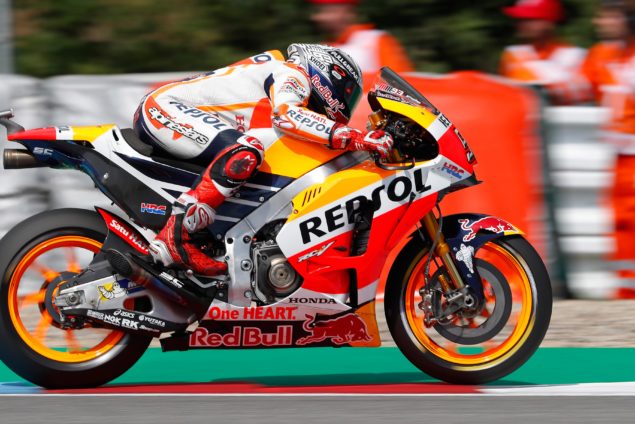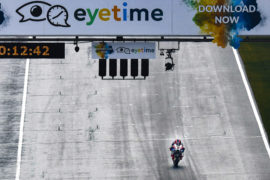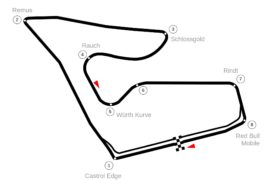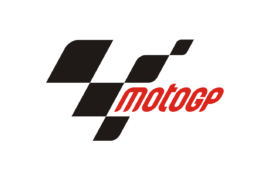If the weather has been the bane of MotoGP this year, then Saturday at Brno made up for an awful lot. The day started out with clear blue skies, and stayed that way just about all day.
It was still bone dry and warm when we left the track as darkness began to fall, though the occasional cloud could be spotted here and there. It was a great day for racing motorcycles.
It was apparently also a great day for crashing motorcycles. In the first session of the day, 40 minutes of free practice for the Moto3 class, 15 riders crashed, all going down like skittles.
Next up it was FP3 for MotoGP, and a further 7 riders hit the deck. Moto2 followed, and 6 more went down. By the end of the day, there had been a grand total of 48 falls.
To put that number into perspective: on Friday, in much dicier conditions, there were only 9 crashes. Over all three days of the 2014 event at Brno, there were 46 crashers.
If there are three more crashes on Sunday – and it’s race day, when risks offer better rewards – then the Automotodrom Brno will seen more crashes than in the previous seven years. They really were going down like flies.
Crash Bonanza
Why the crashes? There were no obvious reasons. The MotoGP FP3 session was briefly red flagged after footage appeared to show fluids leaking from the bike of Alvaro Bautista, but that couldn’t explain the 15 Moto3 youngsters who had hit the deck a session before.
The answer lies perhaps in the circuit: Brno hasn’t been resurfaced since 2008, the track is losing grip and is quite bumpy. That combination – combined, perhaps, with the pent-up enthusiasm of a bunch of racers who have spent four weeks kicking their heels – proved treacherous.
The blue skies meant a blazing sun, and track temperatures soared as the day progressed. With the asphalt over 50°C for FP4 and qualifying, the track became greasy, and grip was in even shorter supply.
Though nowhere near as bad as Jerez or Barcelona, conditions need a little more care than normal. That is hard when you are pushing on or over the limit in pursuit of a good grid slot.
Aleix Espargaro, who crashed in the final corner during MotoGP Q2, explained it succinctly: “I put everything on one card, I risked a lot behind Valentino, maybe I was over the limit, but qualifying is like this, it’s to take risks.” When you take risks, you can crash.
Unless you are Marc Márquez, of course. On his first run during Q2, in just a couple of laps, Márquez lost the front end then saved it, had a massive moment with the rear at Turn 13, then saved the front end again a couple of corners on. For Márquez, risk seems to go unpunished more often than not.
Mr. Pole Doesn’t Aound as Good as Mr. Superpole
Marc Márquez would be rewarded with pole position in the end, his 41st pole position at the 82nd MotoGP race of his career. That is an astonishing statistic: a pole rate of 50%, better than any other rider of the modern era.
Claims that Márquez is the all-time record holder for pole positions in all classes (69) are almost certainly inaccurate.
Official MotoGP statistician Dr. Martin Raines reckons Giacomo Agostini probably had over 90 poles in his career, but records for the era prior to the mid 1970s are poor, and push starts rendered qualifying positions less significant.
However, if Márquez keeps riding for another four or five years, and keeps racking up the poles at his current rate, he should soon put the matter beyond question.
The front row for MotoGP is probably a fairly accurate reflection of the actual pace in dry conditions. There are five or six riders with the same pace, Andrea Dovizioso told reporters, which include the first two rows of the grid.
Marc Márquez and Dani Pedrosa were fast in all conditions, Márquez’s pace particularly impressive in FP4. Márquez regards Pedrosa as his main rival on Sunday, a valid concern given his pace.
Valentino Rossi was deceptively quick too, seemingly a tenth slower than Márquez in terms of pace, but that cannot be trusted. “Both Yamaha riders looks like they improve a lot from yesterday, and tomorrow sure they will improve a little bit more.
Normally Valentino is really fast on Sunday,” Márquez said when asked to give his assessment. Dovizioso believes he has the pace of the front group, and Jorge Lorenzo has regained some of his confidence, with the new Ducati fairing.
Surprisingly, Lorenzo believes he could even be in with a shot at the podium if it rains on Sunday – and by all accounts, it will rain, the only question being how hard, and at what time. “Probably for one of the first times I’m optimistic in case of rain,” he said.
“I’m confident even if I prefer a dry race, because the possibility to make a mistake and crash is lower. But yesterday I felt safe, fast and consistent in the rain so I think we are prepared in case this happens. If you ask me I prefer a dry race, but I also I feel prepared in race conditions because the Ducati gives me very good feeling in these conditions.”
Pushing the Envelope
Ducati’s new fairing – see for more details this story – has helped Lorenzo regain some confidence in the front end, though, and at a track he likes, and with more experience on the Ducati under his belt, things are starting to look up.
“It is a combination of things. Brno has been always a good track for me. Here I’m starting to improve, especially on braking, to make the rear sliding more which I was only doing when I felt really, really confident like in Jerez and Montmelo.
But now I’m making it most of the braking. That’s a good sign. And for sure better front contact, better feeling in most of the corners, this also helps. So it’s a combination of things that makes me have a better pace.”
The new fairing worked well for Danilo Petrucci as well. Though he was forced to go through Q1, the Pramac Ducati rider ended up eighth on the grid.
What was interesting was that the aerodynamic side pods on Petrucci’s fairing were larger than Lorenzo’s, the bottom part extending much lower than it did on the factory bike. Yet the fairing has been homologated as a single item, a Ducati source who asked not to be named confirmed to me.
Because the side pods are held on with bolts, the parts are regarded as detachable, and so Ducati are allowed to run the fairing with and without the detachable parts.
The side pod consists of two parts – an upper section, and a lower section – and as both parts can be detached separately, the fairing can legally be run in several different configurations: without the side pods; with the upper section attached, with the lower section attached, and with both sections attached.
The outer shape of the fairing is determined by the complete side pod when attached.
Spirit? What spirit?
Furthermore, the source confirmed, the fairing has been homologated for all three riders on a Ducati GP17. So far, only Lorenzo and Petrucci have used the fairing, while Dovizioso concentrates on the championship. “Fortunately we have Monday to work on that in a relaxed way,” Dovizioso said.
There is still a downside to the Ducati’s new aerodynamic fairing. Less wheelie and a more planted front comes at the cost of top speed. Jorge Lorenzo lost five or six km/h to his teammate, while Danilo Petrucci fared only a little better, ending up 3 km/h slower.
Though Ducati’s fairing adheres to the letter of the law, it is quite clear that they are treating the spirit of the law in much the same way as Zeus treated Leda. But Ducati cannot really be blamed for such a blatant violation.
The problem lies with those who wrote the rules, though they face a Herculean task. The trouble with rules is that as you try to tighten the rules, all you do is allow loopholes to proliferate. Only spec fairings can fix that, and where’s the fun in that?
Maverick’s travails
If Valentino Rossi feels he has the pace, the same cannot be said for his teammate. Maverick Viñales was left frustrated once again, unable to get his Yamaha M1 to turn as he wanted it to. “We are struggling a lot on the brakes and making corner speed,” Viñales said.
“If you are struggling in both cases, it’s impossible to make a fast lap. So we have to work hard this night and try to improve for tomorrow.”
His problems were not down to the track lacking grip, however. “I think the problem is not on the track, the problem is in our side, in our box that we didn’t find the best set up or the best way to make the bike go in this track,” he said.
The only bright spot was the fact that his pace was better than he had expected using the harder tires. “Looking at the pace, it was not really so bad as I expected from the feeling I got from the bike. So for sure with the medium/medium I can improve the lap time much more and the consistency.”
If FP4 was not as bad as Viñales had feared, the same could not be said for his qualifying. “The qualifying was horrible,” he said. “I had no feeling. It’s the worst qualifying I did with the bike, so we have to pay attention with the work that we did since Friday, because it didn’t get any results.”
Salvation for Viñales may come in the form of the rain expected on Sunday. The Movistar Yamaha rider was quick in the wet, but that won’t solve his problems in the long run. In a week’s time, we have to do this all over again, and a good result in the wet at Brno would only be a quick fix.
In Austria, Viñales and his team have to sit down once again and try to figure out why they can’t get the bike to turn or to stop as Viñales wants.
Experience Counts for Everything
If the track is dry, however, the riders face a different problem. The abrasiveness of the track means the tire drops in the second half of the race, though not massively. “Two or three tenths” was how much Michelin’s Piero Taramasso estimated the pace would drop.
Marc Márquez emphasized that the last ten laps would be where the race was won or lost, tire preservation until then would be crucial. It was an area they had focused on in the test here a couple of weeks ago.
That in itself is ominous. Andrea Dovizioso had focused on tire life at the private test in Barcelona, and gone on to win the race.
Maverick Viñales and Valentino Rossi had worked on tires at the newly resurfaced Le Mans, and battled for victory until the final lap, when Rossi crashed out leaving the win to his teammate. The smart money says it is Honda’s turn on Sunday.
Photo: Repsol Honda
This article was originally published on MotoMatters, and is republished here on Asphalt & Rubber with permission by the author.




